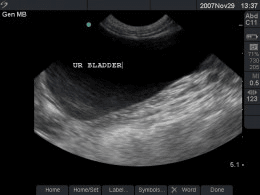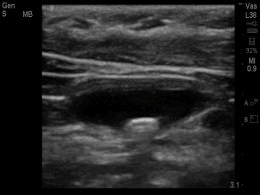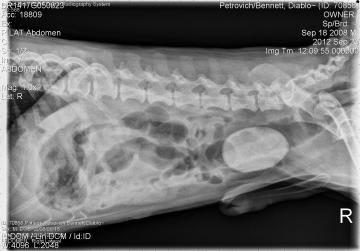
Bladder stones or uroliths are unfortunately a relatively common phenomenon in dogs. They are a stone-like mineral deposit that can form in the bladder and cause urinary issues and pain. Since dogs cannot talk and tell us how they feel, learn how diagnostic tools can aid in determining medical problems and treatment.
Author: Susan Wootten, DVM
Diablo, a very cute Pekingese, who was approximately four years old at the time of this article, was very lucky to find a wonderful new home but unfortunately had been suffering some long term urinary tract problems by the time he got to his new family. They brought him to the Animal Hospital of North Asheville to find out what was wrong. Diablo saw internal medicine specialist, Dr. Golden, in September of 2012. With the help of our non-invasive ultrasound, Diablo was found to have a huge stone that had formed in his bladder. Digital x-rays of the abdomen confirmed an approximately 1 x 2 inch large bladder stone, but fortunately no kidney stones were seen. Poor little Diablo was started on a course of oral antibiotic therapy for the urinary tract infection and scheduled for surgery to remove the stone. The surgery, performed by Dr. Duncan, went well and after a night in the hospital receiving pain medication and lots of TLC all night long, Diablo went home the next day and recovered quickly. The bladder stone was submitted for analysis so that once the results were back, a determination could be made as to the best possible strategy to minimize the chance of more stones forming. Diablo was put on a special diet to help prevent recurrence. His family reported he did well at home.
What are Bladder Stones?
Bladder stones or uroliths are unfortunately a relatively common phenomenon in dogs. They are a stone-like mineral deposit that can form in the bladder, but unlike people, dogs rarely get stones in the kidneys. They can come in several different shapes and sizes and have different mineral compositions. The most common stone types are calcium oxalate and struvite. There can be a genetic or breed related predisposition to certain stone types. Sometimes there are medical conditions that can predispose dogs to developing bladder stones, such as changes in urine pH, history of urinary tract infections, and other underlying health problems like Cushing’s disease. The most important thing is to determine which type of stone it is in order to know treatment options and prevent recurrence.

Normal Bladder

Bladder with Stone
Just like it does in people, urinary tract disease causes discomfort and pain in pets. Pets just have no way to tell us what they are feeling. Some patients with bladder stones may show no symptoms of any kind and the stones are discovered when the pet is being examined for a different problem or during an annual exam when the veterinarian palpates the bladder, but there are symptoms that can indicate there may be stones present. Blood in the urine, recurrent bladder infections, or straining to urinate are common symptoms that would raise suspicion. Frequent straining to urinate without any urine being passed at all can be an indication of a blockage of the urethra, and is an emergency. Fortunately, bladder stones can usually be diagnosed easily. Many stones are radio-opaque, which means they show up readily on radiographs (x-rays). Ultrasound of the bladder is another common and non-invasive way to screen for and identify bladder stones. This procedure can be performed in our hospital with the family present.

Stone in Diablo's Bladder
A urinalysis is needed in these cases and can be performed very quickly in our hospital. Struvite stones can form because of the changes that occur with specific types of bladder infections, so certain types of bacteria may be noted on a urine sediment examination or present on a urine culture. Also, struvite requires an alkaline or higher urine pH to form while oxalate requires an acidic or lower pH to form; urine pH is a part of any urinalysis and thus provides another clue as to the stone identity. Crystals may also be noted on a routine microscopic examination of the urine, and there is a distinct difference in the appearance of struvite (magnesium, ammonium, phosphate) and oxalate (calcium oxalate) crystals. A combination of these diagnostic tests helps guide the veterinarian in making specific recommendations for the pet and formulating a treatment plan.

Occasionally stones may be small enough to simply be passed in the urine; however, this is not always the case, as we saw with Diablo. Struvite stones can be removed in several ways including dissolution with a prescription diet, surgery (cystotomy), and voiding urohydropropulsion.
Dietary dissolution of stones is only possible with struvite bladder stones. Some therapeutic foods are made for the specific purpose of dissolving struvite stones. The therapeutic diet must be the only food fed until the stone is dissolved, and because these stones are due to infection, antibiotics are needed during the entire course of treatment. On average, three and a half months are needed to dissolve the stone and in some cases this treatment may still not be effective. Calcium oxalate stones cannot be dissolved with diet change.
If the stones are small enough to pass, the bladder can be manipulated to expel the stones through the urethra (the tube carrying urine from the bladder to outside the body). This is called voiding urohydropropulsion and it involves filling the bladder, agitating the bladder so the stones float freely in the urine, and then generating a high pressure urine stream to force the stones out. The patient must typically be anesthetized and held vertically so that gravity can assist in the expulsion. This technique only works if the stones are small and works best in female dogs.
Surgical removal, or cystotomy, is the most direct method and is always necessary if the stones pass into the urethra and cause a mechanical obstruction of urinary outflow. The procedure itself has relatively few complications. The patient must be placed under general anesthesia for a cystotomy. Thus, pre-anesthetic blood work is strongly recommended before surgery to ensure that your pet is healthy and to help your veterinarian determine the best anesthetic regime to use. The cystotomy is performed through an incision on the lower belly. The bladder is isolated and an incision is made into the bladder to remove the stones. The stones and a sample of the urine are submitted for analysis and culture. The bladder is flushed thoroughly to make sure no stones remain in the bladder or the urethra, then the bladder incision is sutured and the abdomen is flushed. The abdominal incision is then closed. Before the patient wakes up, we take an x-ray to make absolutely certain that there are no stones left behind.
After stones are removed one way or another and the type of stone is identified, the focus shifts to prevention. Diet plays an extremely important role in making sure the urine pH remains in a range that is recommended for the patient. Increased water consumption to promote a more dilute urine sample is accomplished through canned food diets, increasing water intake, and sometimes diuretics. Bladder infections must be adequately controlled with antibiotic therapy. Some individual animals are predisposed to recurring bladder infections and these individuals may form new struvite stones repeatedly. Repeat urinalysis and urine cultures may be necessary in these patients. Urine pH is monitored closely as well as periodic radiographs and/or ultrasound of the bladder.
There are some metabolic diseases that might predispose a dog to creating calcium oxalate stones. For example, a dog with Cushing's disease will over-produce cortisol (commonly known as cortisone). This hormone increases calcium excretion in urine. The extra calcium in the urine will promote formation of a stone. Some animals may have an elevated blood calcium level (hypercalcemia) for any number of reasons and this could lead to excess calcium in the urine as the body attempts to restore calcium balance. Again, extra calcium in the urine promotes a stone. Screening for such medical conditions is important, which is another reason why blood tests are recommended once stones are detected on a radiograph. If any such metabolic problems are uncovered, they will need to be treated separately.
Thanks to diagnostic testing and surgery, we’re very happy that Diablo is free of bladder stones and we wish him many happy, healthy years with his wonderful new family! He may have been dealt a bad hand in getting urinary tract disease, but he is very lucky to have found a family that loves him so much!
If your dog is have urinary issues, Schedule an Appointment Today! We can help determine causes and offer treatment options.
11/2012
